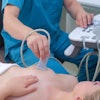NEW YORK CITY - The increasing prevalence of fetal entertainment ultrasound studies has attracted concern among clinicians, professional organizations, some state governments, and the U.S. Food and Drug Administration (FDA) over the possible misuse of scans performed for nonmedical purposes.
But, at least in the experience of a research team from the University of Utah and Intermountain Healthcare in Salt Lake City, patients receiving these scans seem to be aware of their limitations and view them as an adjunct to their medical ultrasound exam.
"The women in our study all viewed keepsake ultrasound as entertainment -- they never thought of it as a replacement for medical care," said Sara Ellis Simonsen. She presented the team's research Saturday at the 2007 American Institute of Ultrasound in Medicine (AIUM) meeting.
To determine the utilization of nonmedical fetal ultrasound (NMFU) and examine patient motivation and experiences with medical and nonmedical scans, the study team conducted a two-stage study. In the first part, the researchers surveyed all the patients at their maternal-fetal medicine ultrasound clinic to determine the prevalence of utilization over two one-week periods.
Of the respondents, 9.3% of patients in the office reported obtaining a keepsake ultrasound during their pregnancy. Among patients who had received one or more keepsake ultrasounds, 63% were interested in obtaining another one during their pregnancy, while 82% were interested in having one during a future pregnancy.
For those who hadn't received a keepsake ultrasound, 32% were still interested in having one during their current pregnancy, while 44% were interested in having one during a future pregnancy.
In the second part of the study, the researchers performed in-depth interviews with 30 patients, 15 of whom had undergone commercial sonography in addition to medical sonography and 15 had only received medical sonography. Patients received a $25 gift card for participating.
As for patient demographics, 93% were Caucasian, 76% had some education after high school, and 87% were married. Women who received NMFU described more pregnancy complications and much higher levels of dissatisfaction with their medical imaging experience, Simonsen said. "They also had lower educational achievement," she added.
From patient interviews, the researchers discovered that the main reason women were seeking the NMFU studies was to learn the fetal gender, followed by obtaining keepsakes such as photos and DVDs, and to be able to see the fetus.
Those who decided to avoid NMFU described reasons such as untrained personnel, general satisfaction with their medical scan, costs, and concern over bioeffects, according to Simonsen.
Patients who had received NMFU scans viewed them as an adjunct to their medical ultrasound, not as a replacement, she said. "They all recognized the value of their medical imaging," Simonsen added.
Fifty-three percent of the patients who sought NMFU were dissatisfied with their medical US scan, citing reasons such as not learning their fetal gender and lack of description of fetal features by the sonographers, she said. In contrast, 13% of those patients who only received medical ultrasound reported dissatisfaction.
These patients found several desirable features with NMFU studies, include longer appointments, acceptance of walk-in visits, a less intimidating atmosphere, friendly staff, and appealing keepsakes such as DVDs set to music and 3D/4D photos, Simonsen said.
From the research, the study team discovered different expectations from ultrasound between providers and patients.
"When patients go to get an ultrasound, they really want to see their fetus to get reassurance, whereas providers really want to do a thorough clinical exam," she said. "We found that the expectations of keepsake ultrasound sites were much more in line with what patients desired when they went in to get an ultrasound, even if it was a medical ultrasound."
To improve patient satisfaction, some aspects of keepsake ultrasound could be incorporated into the medical practice, Simonsen said.
"At our office, we have made some changes based on this research," she said. "This includes longer appointments, more use of 3D imaging, and we now provide DVDs to our patients."
The research found that keepsake ultrasound is relatively common, with 9% of office patients reporting using it during their current pregnancy, Simonsen concluded.
"There's a high level of interest in keepsake ultrasound, and high levels of satisfaction with the keepsake ultrasound experience, and (also) dissatisfaction with medical ultrasound among patients who choose to seek a keepsake ultrasound," Simonsen said.
All women in the study viewed NMFU as entertainment, not as a replacement for their medical ultrasound, she said.
"Changes in office operations may be needed to help meet patient/consumer desires," she said.
By Erik L. Ridley
AuntMinnie.com staff writer
March 20, 2007
Related Reading
Controversy remains over keepsake prenatal ultrasound images, February 2, 2007
Fetal 4D US market grows despite FDA criticism, research finds, November 30, 2006
NJ lawmakers propose restriction on ultrasound sales, July 3, 2006
AIUM: FDA should investigate star's US purchase, November 29, 2005
AMA says ultrasound in-utero "portraits" are bad idea, June 22, 2005
Copyright © 2007 AuntMinnie.com




















